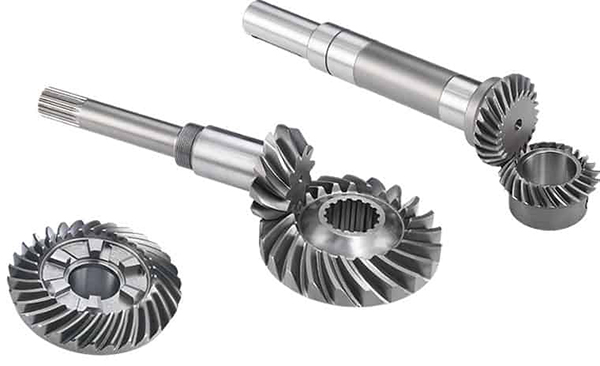Bevel Gear

Bevel Gear
Straight Bevel Gear, Spiral Bevels, Miter, Zerol, Anti-Back Lash Gears & more
Bevel gears are used extensively in a wide variety of industries and mechanical operations due to the most important advantage they offer: smooth and low-noise power transmission between non-parallel shafts at almost any angle or speed. However, due to the mathematical complexity of their design, manufacturing these gears is not an easy process.
AmTech OEM bevel gear manufacturer projects always begin production from a forging, bar stock, or another raw formed product such as a casting, depending on the strength requirements of the finished gearing. A forged blank is used when a superior strength to weight ratio, as well as better impact and fatigue resistance is necessary.
The forging, casting or bar stock is machined into a blank. Threads and splines maybe added on to the blank if the design so requires, and other machining processes such as turning, milling, drilling and tapping etc. are carried out prior to teeth cutting.
MANUFACTURING CAPABILITIES
- Gears
- Flexplate Assemblies
- Flywheel Assemblies
- Shafts
- Machined Castings
- Machined Forgings
- Screw Machining
- Stamping & Fineblanking
- Other Expertise
- Custom Engineering services
Next, the product teeth are cut into the blank. There are two common used manufacturing methods for cutting the teeth, and the tooth length and depth forms vary depending on the process adopted. The Gleason system uses the single indexing or face milling procedure, where every gap is milled separately, and the gear then rotated by the width of that tooth space. Straight bevel gearing produced via this method have a tapered tooth depth and tooth thickness, and the curvature along the face width is that of a circular arc. This results in a coniflex gear, where the ends of the teeth curve slightly inward, allowing for greater tolerance of minor errors in shaft alignment as compared to straight cut teeth.
Oerlikon and Klingelnberg method uses the face hobbing process or the palloid manufacturing process, where the gear rotates constantly during the milling process. This continuous indexing method produces gearing with a constant tooth depth and tapered slot width and tooth thickness. The face width of the tooth is curved like an extended epicycloid. Straight bevel gear manufacturer projects with involute tooth length can only be produced via the face hobbing method.
Depending on the end use of the application, either method may be used to cut teeth.
Next, the gear is subjected to heat treatment – usually case carburizing and hardening, resulting in a surface hardness of 60-63 Rc. The pinion is normally up to 3 Rc harder than the gear to equalize wear and tear. Nitriding, flame hardening and induction hardening are rarely used in bevel gear heat treatment, to avoid significant tooth distortion.